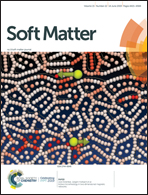A simulation study on the glass transition behavior and relevant segmental dynamics in free-standing polymer nanocomposite films
Abstract
In polymer/nanoparticle composite (PNC) thin films, polymer chains experience strong confinement effects not only at the free surface area but also from nanoparticles (NPs). In this work, the influence of NP–polymer interaction and NP distribution on the polymer segmental dynamics and the glass transition behavior of PNC free-standing films are investigated through molecular dynamics simulations. We demonstrate that NPs will migrate to the film surface area and form an NP-concentrated layer when NP–polymer interactions are weak, while NPs are well dispersed in the bulk region when NP–polymer interactions are strong. In both cases, we find increases in the glass transition temperature Tg compared with the pure film without NPs, although with a different degree. The weakly interacting system has the same Tg as the pure bulk system without NPs. The NP layer formed at the surface area reduces both the mobility of the surface polymer beads and the mobility gradient in the film normal direction (MGFND), therefore resulting in an increase in the Tg which highlights the vital role of the mobile surface layer. In contrast, the NPs in the bulk region enlarge the MGFND. NPs have opposite influences on the polymer bead dynamic anisotropy when they interact weakly or strongly with polymers, weakened for the former and enhanced for the latter. These findings offer a clear picture of the segmental dynamics and glass transition behavior in free-standing PNC films with different NP–polymer interaction strengths. We hope these results will be helpful for the property design of related materials.



 Please wait while we load your content...
Please wait while we load your content...